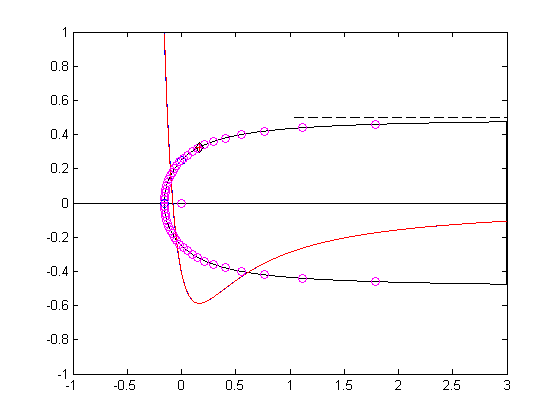Write a matlab solution to Rankine nose problem.
Write a matlab solution to Rankine nose problem.
The Rankine nose or Rankine leading edge is an example of flow around the leading edge of a symmetric aerodynamic body which is symmetric about the x-axis of coordinate system.This flow can be obtained by adding a uniform flow and a source flow at the origin.The velocity potential and stream function of this flow is
\phi=U_{\infty}x+\frac{m}{4\pi}ln\left ( x^{2}+y^{2} \right )\;,\;\psi=U_{\infty}y+\frac{m}{2\pi}tan^{-1}\frac{y}{x}
The velocity field for this flow is u=U_{\infty}+\frac{m}{2\pi}\frac{x}{x^{2}+y^{2}}\;;\;v=\frac{m}{2\pi}\frac{y}{x^{2}+y^{2}}
Matlab solution to the problem is
1 2 3 4 5 6 7 8 9 10 11 12 13 14 15 16 17 18 19 20 21 22 23 24 25 26 27 28 29 30 31 32 33 34 35 36 37 38 39 40 41 42 43 44 45 46 47 48 49 50 51 52 53 54 55 56 57 58 59 60 61 62 63 64 65 66 67 68 69 70 71 72 73 74 | clear;clcdisp('Example: Rankine nose')m = 1; % Source strength for source at (x,y) = (0,0).V = 1; % Free stream velocity in the x-directiondisp(' V m ')disp([V m])disp(' Velocity potential:')disp(' phi = V*x + (m/4/pi)*log(xˆ2+yˆ2)')disp('Stream function:')disp(' psi = V*y + (m/2/pi)*atan2(y,x)')disp('The (x,y) components of velocity (u,v):')disp(' u = V + m/2/pi * xc/(xˆ2+yˆ2)')disp(' v = m/2/pi * y/(xˆ2+yˆ2)')%xstg = - m/2/pi/V; ystg = 0; % Location of stagnation point.%N = 1000;xinf = 3;xd = xstg:xinf/N:xinf;for n = 1:length(xd)if n==1yd(1) = 0;elseyd(n) = m/2/V;for it = 1:2000yd(n) = (m/2/V)*( 1 - 1/pi*atan2(yd(n),xd(n)) );endendendxL(1) = xd(end); yL = -yd(end);for nn = 2:length(xd)-1xL(nn) = xd(end-nn); yL(nn) = -yd(end-nn);endplot([xd xL],[yd yL],'k',[-1 3],[0 0],'k'),axis([-1 3 -1 1])u = V + m/2/pi * xd./(xd.^2+yd.^2);v = m/2/pi * yd./(xd.^2+yd.^2);Cp = 1 - (u.^2+v.^2)/V^2;hold onplot(xd,Cp),axis([-1 3 -1 1])plot(0,m/V/4,'o')plot(xstg,ystg,'o')plot([1 3],[m/2/V m/2/V],'--k')[Cpmin, ixd] = min(Cp);xmin = xd(ixd);ymin = yd(ixd);plot(xmin,ymin,'+r')Cpmin;% Computation of normal and tangential velocity on (xd,yd):phi = V*xd + (m/4/pi).*log(xd.^2+yd.^2);dx = diff(xd); dy = diff(yd); ds = sqrt(dx.^2 + dy.^2);dph = diff(phi); ut = dph./ds; xm = xd(1:end-1) + dx/2;psi = V*yd + (m/2/pi).*atan2(yd,xd);plot(xm,1-ut.^2/V^2,'r')%% Check on shape equation%th = 0:pi/25:2*pi;r = (m/2/pi/V)*(pi - th)./sin(th);xb = r.*cos(th);yb = r.*sin(th);plot(xb,yb,'om')%% Exact location of minimum pressurethm = 0;for nit = 1:1000thm = atan2(pi-thm,pi-thm-1);endthdegrees = thm*180/pi;rm = (m/2/pi/V)*(pi - thm)/sin(thm);xm = rm*cos(thm);ym = rm*sin(thm);plot(xm,ym,'dk')um = V + m/2/pi * xmin/(xmin^2+ymin^2);vm = m/2/pi * ymin/(xmin^2+ymin^2);Cpm = 1 - (um^2+vm^2)/V^2; |




